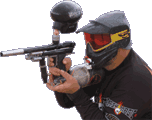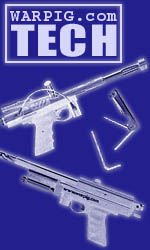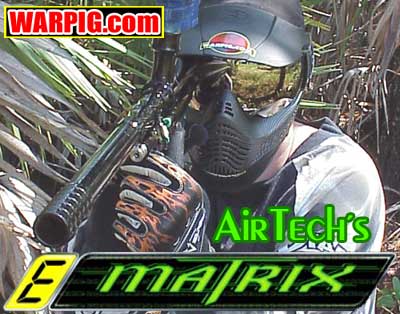  |
|
|
|
|
|
|
  |
|
|
|
|
|
|

What
do you think?
|

AirTech Matrix by Bill Mills June 2001
A Spool Valve Design Spool valve structured paintguns utilize a fixed volume airspace, and a regulated air source to (in theory) deliver a consistent amount of energy to the ball with every shot. The valve is controlled by a spool that slides back and forth like a piston. In one position it allows the regulated gas supply to fill the fixed air chamber, known as the accumulator. In the firing position the spool empties the contents of the accumulator into the breech, firing the paintball.
The spool valve of the Matrix is integrated with the paintgun's bolt. This means that the only major moving part in the upper receiver is the bolt/valve core. As compared to designs of other paintguns, where the bolt is separately actuated, or parallel to a hammer, the inline arrangement is compact and lightweight, keeping the Matrix from being bulky. An intriguing feature to the Matrix valve assembly is that the gas feeding the pilot valve is completely separated from the gas feeding the accumulator. More on this subject later. If there is one drawback to the spool valve in the Matrix, it is the number of o-rings. Between the valve itself, and the spacers and blockers which hold it in place there are 13 o-rings, roughly half of which slide against moving metal, making them wear items.
Removable Breech
The removable breech opens a door for aftermarket manufacturers. Potential aftermarket breeches will likely include different ball detent systems, angled or powerfeed necks, different barrel threading patterns, or even a side feed (with a single mill cut on the receiver) for use with the Warp Feed or other forced feed loaders. Another aftermarket breech possibility would be the inclusion of optical or infra-red sensors that would link to an aftermarket circuit board. Early Matrices (the plural of Matrix) shipped with cast metal grip panels, later to be replaced by molded grip panels. The grip frame shares shape and screw placement with the Angel LCD, allowing LCD compatible grip panels to be installed on the Matrix.
A single switch on the circuit board is accessible from the rear of the grip frame. Selectable between F (fire) and S (safe) this is the power switch for the Matrix. A four conductor connector and wiring leads from the circuit board to the receiver. Two wires lead to the 9 volt battery clip, and two to the solenoid valve. The battery is stored in the rear of the receiver, and can be changed out by removing the central threaded rod and receiver back plate.
Because the arm of the microswitch is made of plastic, it is a good idea for Matrix owners to check their trigger adjustment when first setting up their paintgun. The rear limit set screw should be adjusted to stop the trigger before it pushes the microswitch lever into contact with the body of the microswitch. Mounted vertically to the front of the receiver, is the Matrix regulator. This two piece unit acts as a foregrip while reducing the pressure of the propellant gas before it enters the paintgun. The Matrix operates at very low pressures - about 140 psi - making the regulator a necessity. Because the volume of gas used with each shot is fixed, velocity of the Matrix is adjusted by changing gas pressure. Adjusting the regulator involves twisting the lower half relative to the top half, and it is locked in place with a set screw. The low pressure operation means that the Matrix is not limited to compressed air as a power source. CO2 can also be used, since cold weather, and decompression chilling will almost never drop a CO2 tank's output pressure below what is needed to run the Matrix.
One of the first things many players do when they purchase a paintgun us to rush out and buy a brand name aftermarket barrel, figuring the stock barrel must not be able to compare. The Matrix ships with a 14 inch Custom Products barrel, in .689 inner diameter. This is the "medium" bore size of the 3 offered by Custom Products in their one piece barrels. To test the Matrix, it was loaded up and taken to Spacecoast Paintball, and Command Post's Cow Town field, and tested with Diablo and Great American paintballs. Centerflag Products Hyperflow 201 adjustable and 420 screw in preset 4500 psi compressed air systems, as well as a Crossfire 3,000 psi preset screw in system, mounted on a Shocktech drop forward were used for testing. Additionally test firing was done with a 20 ounce CO2 tank on remote. CO2 should be run with a remote, or with an anti-siphon tank if mounted horizontally to prevent the feeding of liquid CO2. The first impression the Matrix made on most players - even those who hadn't fired it themselves is that it is very quiet. The low operating pressure, few moving parts, and venting pattern of the CP barrel combine to send a lot of paintballs into the air without making much noise. At the 2001 Gettysburg NPPL a player commented that he was shot out from diagonally down the field - he hadn't heard the Matrix that shot him on the open, inflatable bunker field. In the woods, brush muffles the sound even more, giving the Matrix a stealth advantage. Speed - the Matrix has it The Matrix trigger is easy to pull fast, and the paintgun and electronics keep up with the trigger. Firing with consistent velocity, accuracy is a hallmark of the Matrix. Due to the low amount of moving mass in the design, there is very little "recoil" or shake when the Matrix is fired. This means that in practical shooting (not locked down on a bench testing, but use in the real world) it is easier for the player to rapid fire tight shot groupings, rather than having their aim thrown off by the paintgun shaking as they shoot. It was no problem to consistently fire 5 round groups, and put the last three shots (using the first two to walk in on the target) 5" x 5" sheet metal targets at various distances on Space Coast's target range. On the field, it's centerfeed design proved quite adequate when topped with e Revolution loader, to keep up, and the double ball detent system did it's job. Zero ball breaks were experienced during testing - the Matrix, equipped with the low pressure front regulator, is definitely gentle on the paint it shoots.
Impressively, the Matrix handles well on CO2. The reduced cost of CO2 tanks compared to compressed air systems can make them an attractive option. For more advanced players, compressed air still ads the very attractive feature of being able to know how full a tank is by looking at a gauge. With the Matrix regulator handling the final pressure setting, less expensive fixed output "screw in" compressed air systems provide excellent performance for the dollar. With all the good points of the Matrix there must be something that is not top-notch and there is - gas efficiency. The lower the pressure of a gas, the less stored energy it carries. Because the Matrix runs at such a low pressure, it needs a lot of gas to operate at proper velocities. 4500 psi systems are definitely advantageous for the Matrix, due to the greater amount of gas they carry for a given tank size. 700 to 800 shots on a 68 cubic inch 4500 psi system seems to be the norm found in this field test and informal polling of various Matrix owners. Back players who plan to shoot more paint will definitely want to go with larger tanks, perhaps even 114s. The use of high quality paint, and a precise barrel to paint match can also help bring up the number of shots per fill by increasing gas efficiency.
Another area of concern with the Matrix is the connection between its regulator and the receiver. While damage here has not been seen yet, it is a slender connection and has the potential to be damaged after a heavy impact. Structural support for this joint may well appear as an aftermarket accessory. An Impressive Paintgun While still relatively new the Matrix is already appearing in custom versions. Airsmith Danny Love is producing custom Matrices under the Shockteck name. In addition to cosmetics, and the Shocktech hoseless low pressure bolt regulator, spacers inside the accumulator reduce the volume of airspace, increasing the gas pressure used to fire the ball, and decreasing the recharge time. This improves gas efficiency, while the separated control and exhaust gas systems allow the bolt to still move under the power of gentle, low pressure gas. The decreased recharge time reduces the possibility of velocity drop when rapid firing. All in all, the AirTech Matrix is a very impressive paintgun. It has a slim profile, is very easy to set up, adjust and maintain, it is capable of high rates of fire, and has excellent accuracy. The standard Matrix includes a high end barrel, and will operate on compressed air or CO2. While it is making a name for itself in tournament circles, being used by pro and top amateur players, it will probably also gain popularity amongst scenario and big game players where the stealth factor of quiet operation, and its accuracy make it well suited to sniper-like play. There are also new features down the road for the Matrix, planned around the electronics. Prototype circuit boards at AirTech are working with some new features that are a generation past anything on the market today. The author would like
to thank the following:
|
||||||||||||||||||||||||||||||||||||||||||||||||||||||||||||||||||||||||||||||||||||||||||||||||||||||
| Copyright © 1992-2019
Corinthian Media Services. WARPIG's webmasters can be reached through our feedback form. All articles and images are copyrighted and may not be redistributed without the written permission of their original creators and Corinthian Media Services. The WARPIG paintball page is a collection of information and pointers to sources from around the internet and other locations. As such, Corinthian Media Services makes no claims to the trustworthiness or reliability of said information. The information contained in, and referenced by WARPIG, should not be used as a substitute for safety information from trained professionals in the paintball industry. |